Contents
- The climate of Salt Lake City
- The best time to visit Salt Lake City
- The worst time to visit Salt Lake City
- Spring weather in Salt Lake City
- Summer weather in Salt Lake City
- Autumn weather in Salt Lake City
- Winter weather in Salt Lake City
- Weather in January
- Weather in February
- Weather in March
- Weather in April
- Weather in May
- Weather in June
- Weather in July
- Weather in August
- Weather in September
- Weather in October
- Weather in November
- Weather in December
- Frequently asked questions
- Average temperature
- Average pressure
- Average wind speed
- Average humidity
- Average rainfall
- Average rainfall days
- Average snowfall
- Average snowfall days
- Average daylight
- Average sunshine
- Average sunshine days
- Average UV index
- Average cloud cover
- Average visibility

Climate and monthly weather forecast
The climate of Salt Lake City
Analysis of the climatological parameters reveals that throughout the annual cycle, temperatures fluctuate between 21°F (-6.1°C) to 84.7°F (29.3°C), the cold being in the winter months of December to February, and summer time (June to August) offering the highest temperatures. Humidity takes a downward dip during the summer, decreasing to around 37%, while the relative humidity reaches at its utmost, 83% at the coldest months.
Rainfall throughout the year is relatively constant, with the maximum monthly average rainfall hitting at 0.51" (13mm). Interesting patterns emerge in the form of snowfall, where December records an average snowfall of 1.67" (42mm) over a period of approximately 6.2 days. In contrast, the warmer months from May to September register no snowfall. In terms of daylight, June witnesses the longest sunlight hours, stretching up to 15.1 hours, while December provides the shortest, around 9.3 daylight hours.
Cloud cover is minimal during the sunny days of summer, with just around 9-13% cloud cover from June to August. In contrast, winter days in Salt Lake City are cloudier with an average of 38% cloud cover in December and January. The region experiences a slightly breezy air current throughout the year, with wind speeds reaching up to 6.6mph (10.6km/h) on average.
The best time to visit Salt Lake City
The worst time to visit Salt Lake City
Spring weather in Salt Lake City
Summer weather in Salt Lake City
Autumn weather in Salt Lake City
Winter weather in Salt Lake City
Weather in January
Weather in February
Weather in March
Weather in April
Weather in May
Weather in June
Weather in July
Weather in August
Weather in September
Weather in October
Weather in November
Weather in December
Published by: Weather U.S. | About Us
Data Sources | Weather Forecasting & Climate
Frequently asked questions
What time of the year is the coldest?
What is the most humid month?
How much does it rain?
When does it snow?
What is the snowiest month?
How much does it snow?
What is the month with the least sunshine?
What is the month with the lowest UV index?
What is the wettest month?
When is Daylight Saving Time (DST)?
When it does not snow?
When are the longest days?
When is the highest UV index?
What time of the year is the hottest?
What is the least humid month?
What is the month with the most sunshine?
What is the driest month?
What is the month with the shortest days?
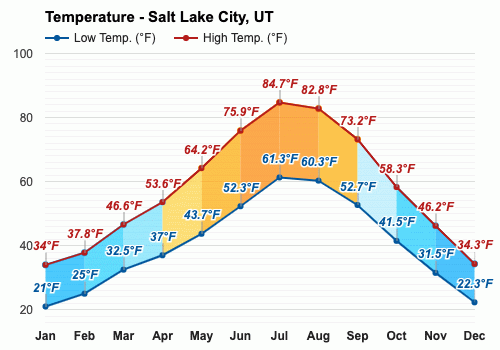
Average temperature
Salt Lake City, UT
The warmest month (with the highest average high temperature) is July (84.7°F).
The month with the lowest average high temperature is January (34°F).
The month with the highest average low temperature is July (61.3°F).
The coldest month (with the lowest average low temperature) is January (21°F).
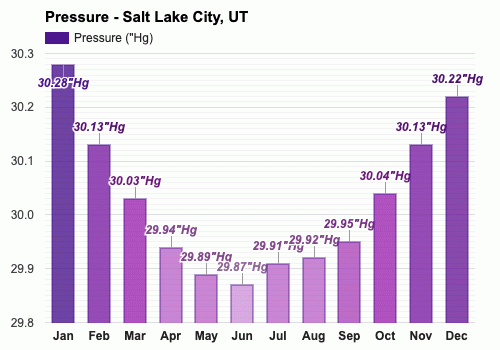
Average pressure
Salt Lake City, UT
- Average pressure in January:
30.28"Hg - Average pressure in February:
30.13"Hg - Average pressure in March:
30.03"Hg - Average pressure in April:
29.94"Hg - Average pressure in May:
29.89"Hg - Average pressure in June:
29.87"Hg
- Average pressure in July:
29.91"Hg - Average pressure in August:
29.92"Hg - Average pressure in September:
29.95"Hg - Average pressure in October:
30.04"Hg - Average pressure in November:
30.13"Hg - Average pressure in December:
30.22"Hg
The month with the highest atmospheric pressure is January (30.28"Hg).
The month with the lowest atmospheric pressure is June (29.87"Hg).

Average wind speed
Salt Lake City, UT
- Average wind speed in January:
5mph - Average wind speed in February:
6.2mph - Average wind speed in March:
6.6mph - Average wind speed in April:
6.4mph - Average wind speed in May:
5.7mph - Average wind speed in June:
6.1mph
- Average wind speed in July:
5.8mph - Average wind speed in August:
6mph - Average wind speed in September:
5.8mph - Average wind speed in October:
5.7mph - Average wind speed in November:
6mph - Average wind speed in December:
5.7mph
The windiest month (with the highest average wind speed) is March (6.6mph).
The calmest month (with the lowest average wind speed) is January (5mph).

Average humidity
Salt Lake City, UT
The month with the highest relative humidity is January (83%).
The month with the lowest relative humidity is July (37%).
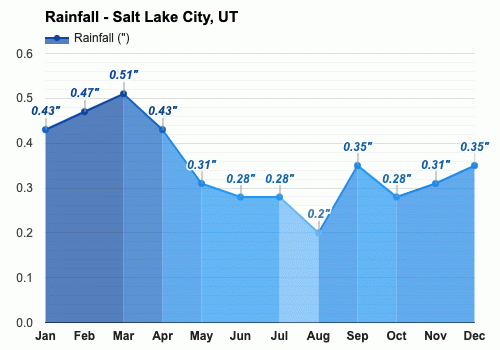
Average rainfall
Salt Lake City, UT
- Average rainfall in January:
0.43" - Average rainfall in February:
0.47" - Average rainfall in March:
0.51" - Average rainfall in April:
0.43" - Average rainfall in May:
0.31" - Average rainfall in June:
0.28"
- Average rainfall in July:
0.28" - Average rainfall in August:
0.2" - Average rainfall in September:
0.35" - Average rainfall in October:
0.28" - Average rainfall in November:
0.31" - Average rainfall in December:
0.35"
The wettest month (with the highest rainfall) is March (0.51").
The driest month (with the least rainfall) is August (0.2").

Average rainfall days
Salt Lake City, UT
- Average rainfall days in January:
5.6 days - Average rainfall days in February:
5.4 days - Average rainfall days in March:
8.7 days - Average rainfall days in April:
8.9 days - Average rainfall days in May:
7 days - Average rainfall days in June:
4 days
- Average rainfall days in July:
5.4 days - Average rainfall days in August:
4.8 days - Average rainfall days in September:
5 days - Average rainfall days in October:
5.6 days - Average rainfall days in November:
4.9 days - Average rainfall days in December:
6.3 days
The month with the highest number of rainy days is April (8.9 days).
The month with the least rainy days is June (4 days).

Average snowfall
Salt Lake City, UT
The month with the highest snowfall is January (2.68").
The months with the least snowfall are May, June, July, August and September (0").

Average snowfall days
Salt Lake City, UT
- Average snowfall days in January:
6.6 days - Average snowfall days in February:
6.6 days - Average snowfall days in March:
3.6 days - Average snowfall days in April:
1.3 days - Average snowfall days in May:
0.1 days - Average snowfall days in June:
0 days
- Average snowfall days in July:
0 days - Average snowfall days in August:
0 days - Average snowfall days in September:
0 days - Average snowfall days in October:
0.6 days - Average snowfall days in November:
1.9 days - Average snowfall days in December:
5.1 days
The months with the highest number of snowfall days are January and February (6.6 days).
The months with the least snowfall days are June, July, August and September (0 days).
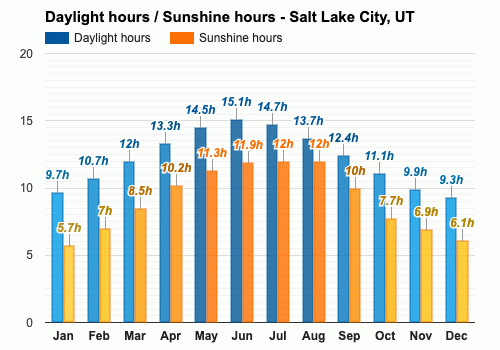
Average daylight / Average sunshine
Salt Lake City, UT
- Average daylight in January:
9h and 4min - Average daylight in February:
10h and 4min - Average daylight in March:
12h and 0min - Average daylight in April:
13h and 2min - Average daylight in May:
14h and 3min - Average daylight in June:
15h and 1min
- Average daylight in July:
14h and 5min - Average daylight in August:
13h and 4min - Average daylight in September:
12h and 2min - Average daylight in October:
11h and 1min - Average daylight in November:
9h and 5min - Average daylight in December:
9h and 2min
The month with the longest days is June (Average daylight: 15h and 6min).
The month with the shortest days is December (Average daylight: 9h and 18min).
- Average sunshine in January:
5h and 4min - Average sunshine in February:
7h and 0min - Average sunshine in March:
8h and 3min - Average sunshine in April:
10h and 1min - Average sunshine in May:
11h and 2min - Average sunshine in June:
11h and 5min
- Average sunshine in July:
12h and 0min - Average sunshine in August:
12h and 0min - Average sunshine in September:
10h and 0min - Average sunshine in October:
7h and 4min - Average sunshine in November:
6h and 5min - Average sunshine in December:
6h and 1min
The months with the most sunshine are July and August (Average sunshine: 12h and 0min).
The month with the least sunshine is January (Average sunshine: 5h and 42min).

Average sunshine days
Salt Lake City, UT
- Average sunshine days in January:
21.9 days - Average sunshine days in February:
19 days - Average sunshine days in March:
19.7 days - Average sunshine days in April:
19.3 days - Average sunshine days in May:
22 days - Average sunshine days in June:
23.8 days
- Average sunshine days in July:
21.8 days - Average sunshine days in August:
22.5 days - Average sunshine days in September:
22.4 days - Average sunshine days in October:
22.8 days - Average sunshine days in November:
23.4 days - Average sunshine days in December:
21.7 days
The month with the most sunshine days is June (23.8 days).
The month with the least sunshine days is February (19 days).
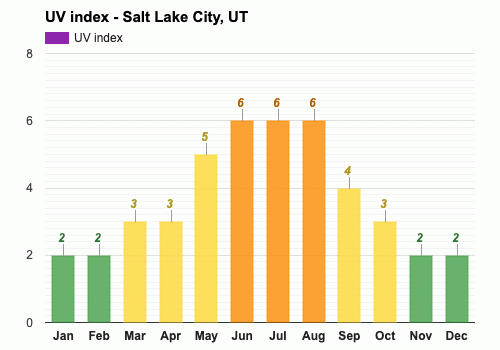
Average UV index
Salt Lake City, UT
The months with the highest UV index are June, July and August (UV index 6).
The months with the lowest UV index are January, February, November and December (UV index 2).
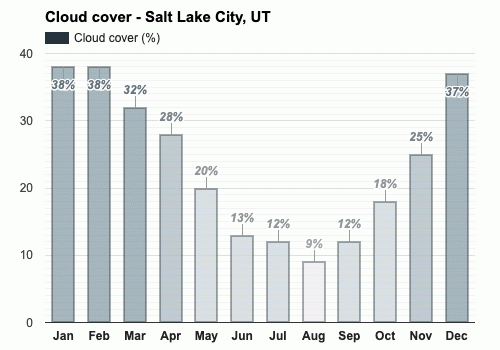
Average cloud cover
Salt Lake City, UT
The months with the most cloud cover are January and February (Cloud cover 38).
The month with the least cloud cover is August (Cloud cover 9).

Average visibility
Salt Lake City, UT
The months with the highest visibility are February, March, April, May, June, July, August, September, October, November and December (6mi).
The month with the lowest visibility is January (5mi).